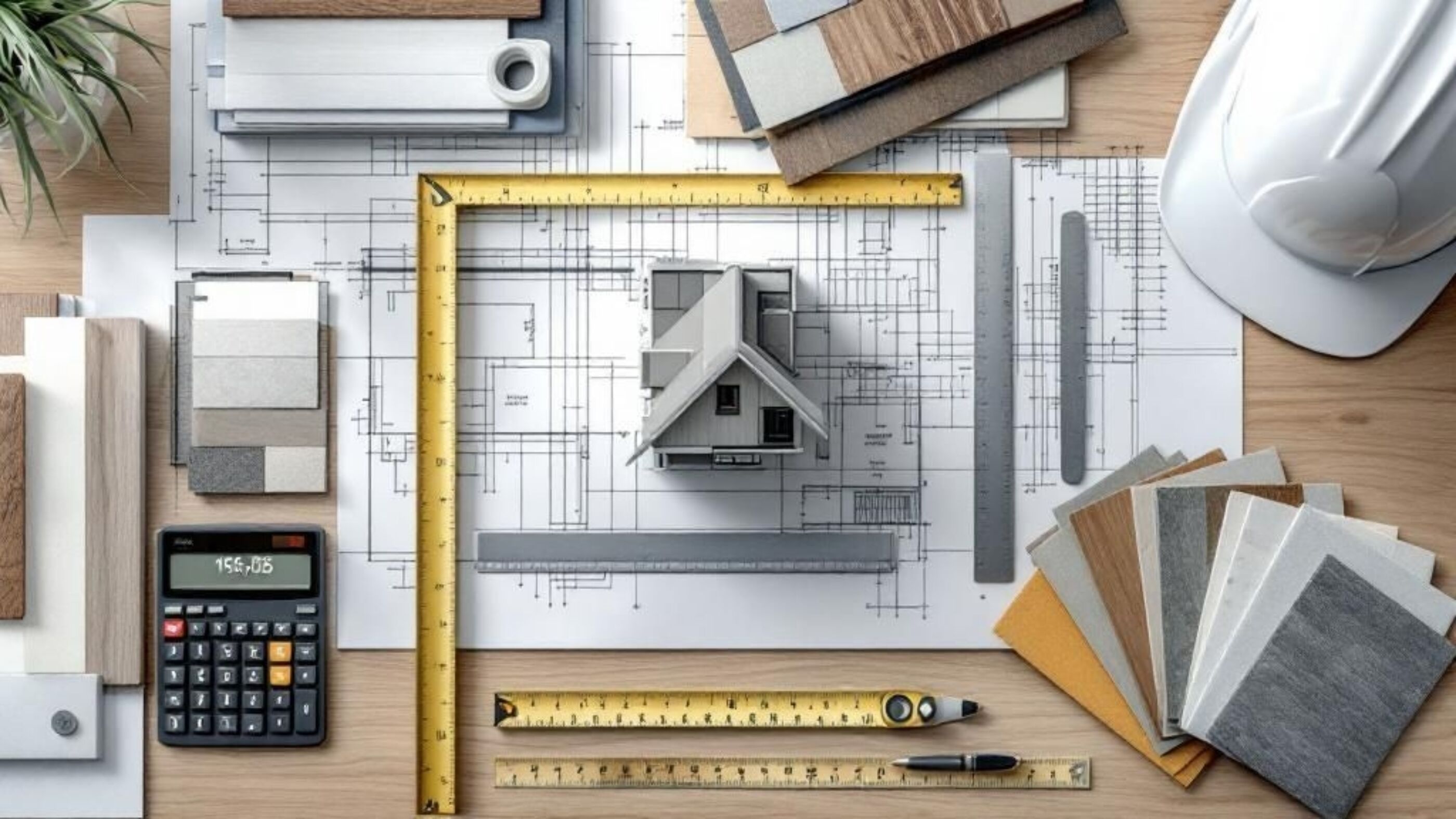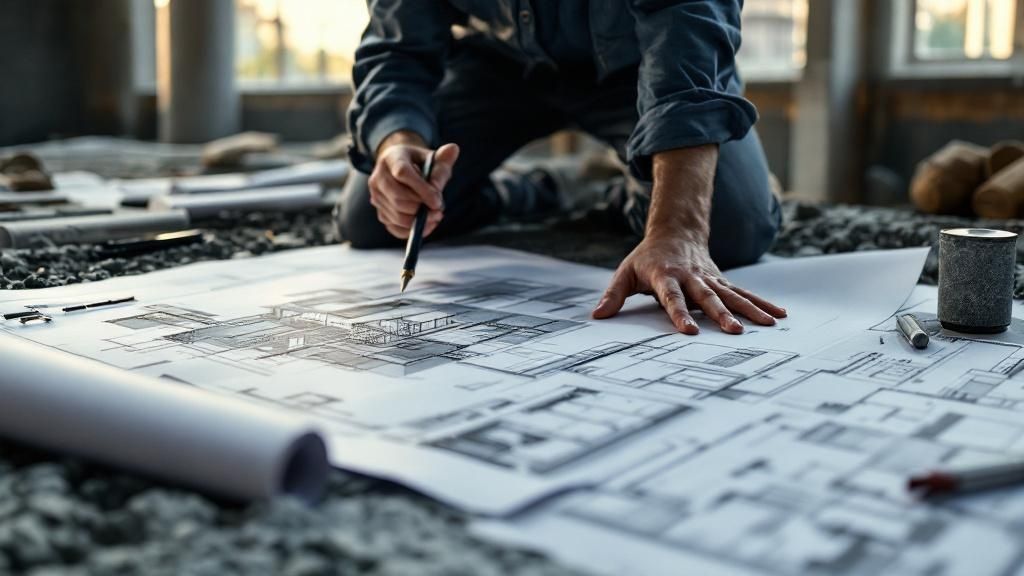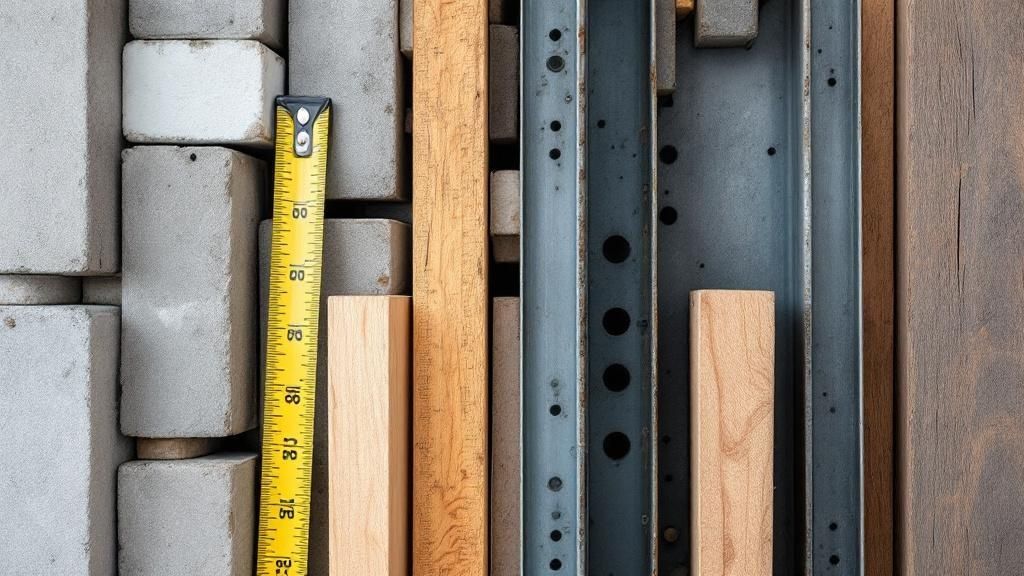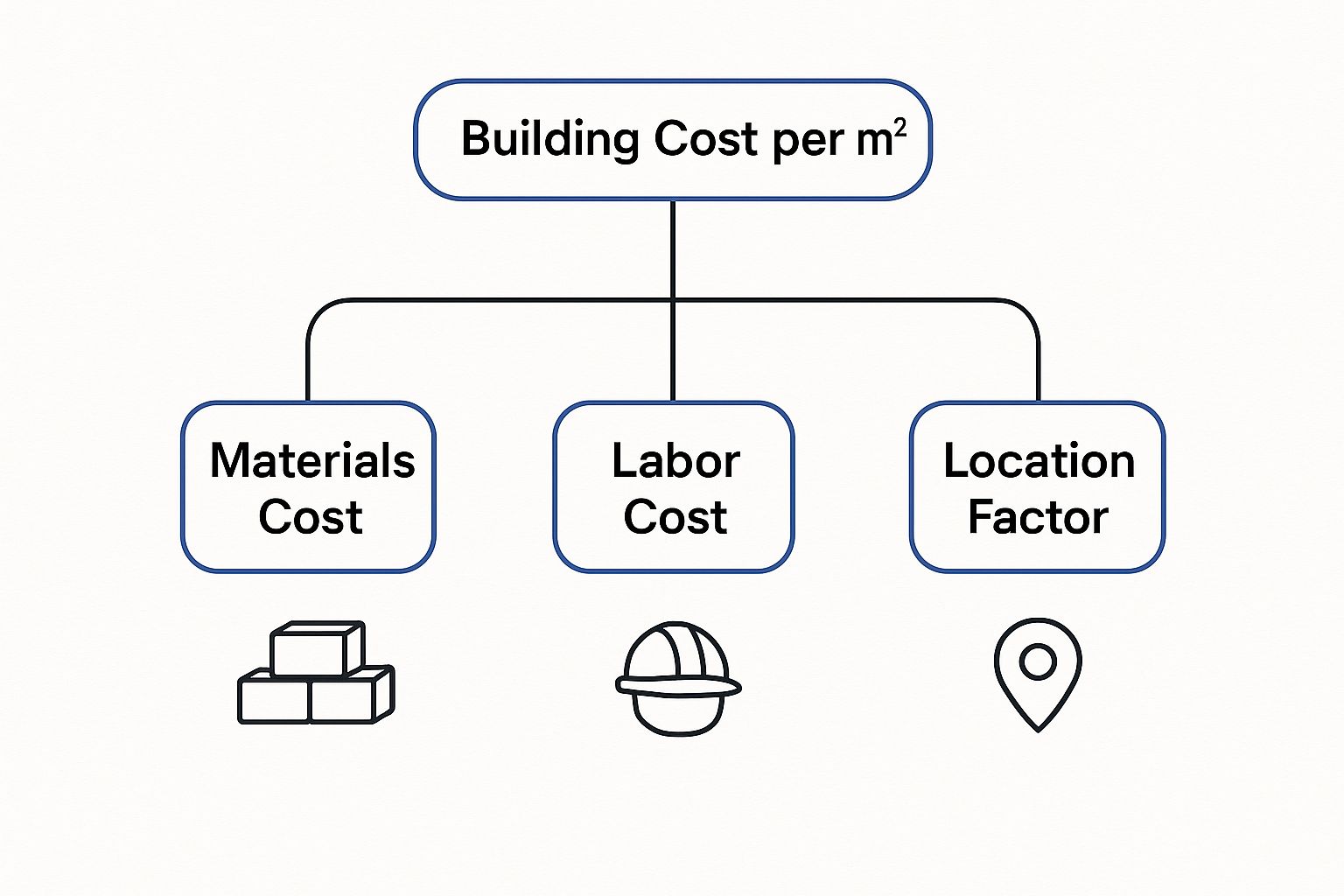Malvern EastProject Repton , 2025
“The key thing we were looking for was the consistency in the pricing that we received, having the right team to be able to problem solve when an issue arose, they did it in a very calm and measured manner. They're a great team and we worked so well together, had we done the design with Envy it would have saved us 6 months minimum”
Building Cost Per Square Metre A Definitive Guide

When you first start thinking about building a new home, the term "building cost per square metre" almost always pops up. It sounds like a simple, neat way to get a quick budget estimate. But in reality, especially for high-quality, custom-built homes in suburbs like Caulfield, this metric can be one of the most misleading concepts in the entire building process.
It gives you a number, sure, but that number rarely paints an accurate picture of the true investment required for a home that’s uniquely yours.
Why 'Cost Per Square Metre' Is Misleading

Let's be blunt: trying to budget for a bespoke home using a square metre rate is like trying to price a car 'per kilogram'. A basic hatchback and a high-performance sports car might weigh about the same, but their value, engineering, and craftsmanship are worlds apart. It’s the exact same story with building a home.
A generic rate tells you nothing about the quality of the materials going into your build, the complexity of the architectural design, or the calibre of the finishes you've chosen.
For custom building and architectural homes, there really isn't any standard cost per square metre. Each home is unique with different finishes, fixtures and fittings and style; these types of homes need to be priced individually by an experienced builder such as Envy Abode.
Debunking the Myth of a Standard Rate
The idea of a one-size-fits-all cost is tempting because it makes a complex process feel simple. The problem is, this oversimplification almost always leads to unrealistic expectations. An architectural home isn't a mass-produced item off a shelf; it's a one-of-a-kind creation.
For a unique architectural home, every detail is bespoke. A true cost is built from the ground up, based on specific plans and selections, not averaged down from a generic number that ignores your individual vision.
A genuine cost is meticulously built from the ground up, accounting for every single detail, not just averaged out from some vague industry figure.
What a Per-Metre Rate Fails to Capture
A simple calculation can't possibly account for all the critical variables that define a custom home. For instance, it completely glosses over:
- Design Complexity: An intricate floor plan with curved walls, double-height voids, or extensive custom glazing will always cost more than a simple, boxy layout.
- Site Conditions: The cost to build on a flat, easily accessible block in Caulfield is fundamentally different from building on a sloping site with difficult access or challenging soil conditions.
- Quality of Finishes: The gap between standard laminate benchtops and imported Calacatta marble, or basic tapware versus high-end designer fixtures, can easily add tens of thousands to the final price tag.
A detailed quote from a builder like Envy Abode breaks all these elements down, giving you a transparent and accurate financial roadmap. This approach empowers you to make informed decisions based on reality, ensuring your dream home gets built exactly how you imagined it—without any nasty budget surprises.
The Reality of Pricing a Custom Caulfield Home

When you’re setting out to build a one-of-a-kind home in a suburb like Caulfield, the idea of a standard building cost per square metre gets thrown out the window almost immediately. It’s a handy metric for volume builders working with set plans, but for a truly architectural home? It just doesn’t fit. A custom home is a direct reflection of your vision, where every single finish, fixture, and feature is a deliberate choice—not something picked from a limited catalogue.
Think of it like commissioning a bespoke piece of art. The artist wouldn’t charge you based on the size of the canvas alone. The final price is a blend of the subject’s complexity, the quality of the paints, the hours invested, and the sheer skill involved. Pricing a custom Caulfield home works the exact same way. The square metreage is just the canvas.
This is precisely why trying to apply a generic rate is not only inaccurate but can set you up with misleading budget expectations from day one. Your project has its own unique DNA, and a standard rate simply can't account for that.
Why Every Custom Home Needs a Custom Quote
The argument against a flat-rate price is simple: for custom building and architectural homes, there really isn't any standard cost per square metre. Each home is unique with different finishes, fixtures and fittings and style; these types of homes need to be priced individually by an experienced builder such as Envy Abode.
This tailored approach is essential because there are countless variables at play. A builder has to meticulously account for every detail specified by you and your architect to put together a quote that’s both transparent and reliable.
A custom home budget isn’t an estimate based on averages; it's a detailed summation of thousands of individual choices. From the structural engineering of a cantilevered balcony to the specific vein match of a marble splashback, every decision carries a precise cost.
Getting into this level of detail is fundamental to the custom building process. It ensures there are no nasty surprises down the track and that the home you end up with perfectly matches your aesthetic goals and your financial investment.
The Unique Variables of an Architectural Build
So, what are these variables that make a standardised rate so useless? The list is long, but a few key factors consistently shape the final cost and show why a bespoke quote is the only way to go.
- Unique Designs and Complex Engineering: An architectural home often pushes the boundaries of design. Features like curved walls, soaring voids, huge glass panels, or intricate rooflines demand specialised engineering and highly skilled tradespeople—things a simple square metre rate completely misses.
- Premium and Imported Materials: The cost difference between standard building materials and high-end selections is massive. Choosing imported European oak floors over a local timber, or specifying natural stone cladding instead of brick, fundamentally changes the entire cost structure of the build.
- High-End Fixtures and Fittings: Your choice of tapware, lighting, appliances, and joinery has a huge impact. A kitchen with standard cabinetry will have a vastly different price tag than one featuring custom-milled joinery and integrated European appliances.
- Bespoke Craftsmanship: Architectural homes often demand a level of craftsmanship that’s a world away from standard construction. We’re talking about custom steel fabrication for staircases, detailed tiling work, or complex joinery that requires a master artisan. This dedication to quality is a hallmark of a luxury build, but it’s something a generic cost-per-metre figure can never capture.
Ultimately, a custom home in Caulfield is a statement of individuality. Its cost is a direct reflection of the unique design, superior materials, and expert craftsmanship that bring it to life. The only way to accurately pin down that cost is with a detailed, itemised quote from a builder who understands that your home is anything but standard.
Key Factors That Drive Your Building Costs
Once you move past that simplistic, and frankly, often misleading building cost per square metre rate, you can start to see where your investment is really going. There are five main drivers that dictate the final price tag of a custom home, and each one has the power to swing your budget significantly. Getting a handle on these is the first step toward creating a realistic financial plan for your project.
The final cost of any build is a complex cocktail of materials, labour, and location-specific variables. This infographic gives a great birds-eye view of the core components that come together to form the total building cost.

As you can see, your final budget is a blend of tangible costs like materials, the skill and time of tradespeople, and the unique economic climate of your area. Let's break down the variables hiding within each of these elements.
Site Conditions and Preparation
Before a single slab gets poured, the land itself throws the first set of cost variables your way. A perfectly flat, clear block with stable soil is the dream scenario, but it's rarely the reality—especially in established suburbs like Caulfield.
The unique character of your site can demand a serious upfront investment. Key things to look out for include:
- Slope and Topography: A sloping block isn't just a challenge; it's an expense. It calls for more extensive excavation, retaining walls, and specialised foundation engineering just to create a level building platform.
- Soil Type: That reactive clay soil so common across Melbourne might force you to go with deeper, more robust foundations (like screw piles or bored piers) compared to what you'd need for stable, sandy soil. This adds both material and engineering costs to the bill.
- Access Challenges: A narrow street or tricky access for trucks and machinery can ramp up labour hours and mean we have to use smaller, less efficient equipment. This is where proper site preparation for construction becomes a critical first step with major budget implications.
Design Complexity and Architectural Ambition
This is where your vision truly starts to shape the budget. The gap between a straightforward rectangular home and an ambitious architectural statement is immense. Non-standard layouts, intricate details, and unique structural features are all significant cost drivers.
Think of it this way: a simple design uses standard materials and construction methods, which are efficient and predictable for us to build. On the other hand, complex designs often need custom fabrication, more labour-intensive installation, and higher-grade engineering. A home with huge open-plan spaces, double-height ceilings, or a cantilevered second storey will demand a lot more structural steel than a conventional build, for example.
Every curve, corner, and custom window adds a layer of complexity that a generic square metre rate simply cannot account for. Your architectural ambition is a primary factor in moving your project from a standard build to a bespoke creation.
Structural Needs and Framing Choices
The very skeleton of your home—its foundation and frame—is a fundamental cost centre. The choices made here are driven by both your design and the site conditions we just talked about. A concrete slab-on-ground foundation is pretty standard for flat sites, but a complex design or poor soil might mean we need a more elaborate and expensive suspended slab or sub-floor structure.
Likewise, the choice between timber and steel framing affects the budget. While timber is often more cost-effective for standard designs, complex architectural forms with wide spans might necessitate a structural steel frame, which comes at a premium for both the materials and the expertise needed to install it.
Quality of Finishes and Inclusions
The fixtures, fittings, and finishes are where your budget can fluctuate the most dramatically. This is the "jewellery" of your home—the elements you'll see and touch every single day. The cost difference between a basic, functional finish and a luxury, high-end one can be astronomical.
Just look at the range of options for a few key items:
- Benchtops: Laminate vs. engineered stone vs. premium natural marble.
- Flooring: Vinyl planks vs. solid Australian hardwood vs. imported European oak.
- Windows: Standard aluminium frames vs. thermally broken, double-glazed architectural suites.
- Appliances: Entry-level brands vs. high-end European integrated appliances.
Each of these decisions multiplies across every room in the house, creating a massive potential variance in the final cost. To really see how this plays out, we've broken down how inclusions change from a standard to a luxury build.
Cost Drivers Breakdown From Standard to Luxury Builds
This table shows how selecting different quality levels for key components can dramatically affect the overall building cost, moving you far beyond a simple square metre rate.
Component | Standard Level Inclusions | Premium Level Inclusions | Luxury/Custom Inclusions |
Kitchen Benchtops | Laminate or basic engineered stone (20mm). | Mid-range engineered stone (e.g., Caesarstone) or quality timber. | High-end natural stone (marble, quartzite), custom concrete, or premium engineered surfaces. |
Flooring | Vinyl plank or entry-level carpet. | Quality engineered timber, Australian hardwood, or mid-range tiles. | Imported European oak, polished concrete with hydronic heating, or high-end natural stone tiles. |
Windows | Standard residential aluminium frames with single glazing. | Commercial-grade aluminium frames with double glazing. | Thermally broken, double-glazed architectural suites; custom steel-framed windows; automated smart glass. |
Appliances | Standard freestanding appliances from domestic brands. | Integrated mid-range European appliances (e.g., Bosch, Smeg). | Top-of-the-line integrated appliances (e.g., Gaggenau, Sub-Zero), plus wine fridges, steam ovens, etc. |
Tapware & Fixtures | Basic chrome tapware and ceramic basins from volume suppliers. | Designer tapware (brushed nickel, matte black), stone composite sinks. | Bespoke tapware from high-end brands (e.g., Vola), custom-fabricated sinks, imported fixtures. |
Joinery | Laminex or Polytec standard finish with basic hardware. | 2-pac painted joinery, veneer finishes, soft-close hardware throughout. | Custom-designed joinery with exotic veneers, integrated lighting, and premium European hardware. |
As you can see, the jump from "standard" to "luxury" is not just one big decision but a series of smaller choices that add up across the entire project.
External Factors and Market Conditions
Finally, forces that are completely outside your direct control will also play a role. Council regulations, building codes, and planning overlays can impose requirements that add costs, such as mandating specific materials for bushfire-prone areas or accounting for heritage considerations in suburbs like Caulfield.
Broader economic conditions have a huge impact, too. In Australia, the average building cost per square metre for residential construction can fluctuate, typically falling somewhere between $3,300 to $7,300. This wide range reflects national trends influenced by material availability, inflation, and skilled labour shortages—all of which can throw a spanner in the works for project timelines and budgets.
Project Home vs Architectural Build Cost Differences
When you start digging into the building cost per square metre, it quickly becomes clear that not all homes are created equal. The market is really split into two camps: project homes and architectural homes. Getting your head around the difference between these two is the secret to setting a realistic budget from day one.
I like to use a suit analogy. A project home is like a great off-the-rack suit. It’s made from a proven pattern, produced efficiently, and you get fantastic value for a predictable price. An architectural home, on the other hand, is pure bespoke tailoring. Every cut is unique, the fabric is chosen by you, and the final result is a one-of-a-kind piece that fits you and only you, perfectly.
Both have their place, but the process, quality, fit, and final price tag are worlds apart.
The Project Home Pricing Model
Project home builders are masters of efficiency. They can offer what seems like an incredibly low square metre rate because their whole business is built on repetition and scale. It all comes down to a few clever strategies:
- Standardised Plans: They operate from a portfolio of pre-designed floor plans. These have been tweaked and perfected over time to be as efficient as possible to build, cutting out complex engineering and tricky structural work.
- Bulk-Purchased Materials: When you’re building hundreds of homes, you can negotiate some serious discounts on everything from timber frames to tapware. Some of those savings get passed on to you.
- Repeatable Processes: Their build teams are like a well-oiled machine. They’ve built the same designs so many times that they can do it quickly and with minimal fuss, which naturally brings down labour costs.
This streamlined system means they can give you a clear, upfront cost, but the trade-off is often very limited wiggle room for custom changes.
The Architectural Home Pricing Reality
An architectural home is a whole different beast. It’s a one-off creation designed from scratch to suit your lifestyle, your personality, and the unique quirks of your block of land. For these custom builds, especially in suburbs like Caulfield, there's simply no such thing as a "standard" cost per square metre.
Each home is unique with different finishes, fixtures and fittings and style; these types of homes need to be priced individually by an experienced builder such as Envy Abode. It’s a meticulous process, but it ensures every last detail is factored in, right from the slab up.
The real value of an architectural home is its uniqueness. The cost is a direct reflection of the creative design, superior craftsmanship, and premium materials needed to bring a personal vision to life—things a standardized rate could never hope to capture.
The final price isn't based on an average; it's painstakingly calculated by adding up the cost of thousands of individual components and the labour required to put them all together.
Why the Cost Models Are So Different
At its heart, the difference comes down to customization versus standardization. A project home starts with a base price, and you add costs for any changes or upgrades. An architectural home’s cost, however, is built from the ground up, determined by the specific design and your selections from the very beginning.
Understanding this is crucial. A project home gives you cost certainty, while an architectural build delivers a home that is a true extension of who you are. If you're leaning towards a custom build, it helps to get familiar with the integrated approach of design and construction, which we explore in our article on the design-build pros and cons.
This move towards higher-quality, bespoke homes is happening as construction costs in general continue to rise. Looking back, over the 15 years leading up to 2018-19, the cost of building a new house in Australia climbed significantly. Data from the Australian Bureau of Statistics reveals the average cost shot up by 59.5%, from around $200,802 to $320,238. This long-term trend underscores just how much of an investment a new home is, making a detailed, accurate quote more critical than ever.
How An Experienced Builder Provides An Accurate Quote

So, we've covered the theory. Now it’s time to talk about what really matters: your budget. This is where you move away from generic building cost per square metre guides and start a real conversation with a specialist builder. For a high-end custom home in a discerning area like Caulfield, an accurate quote isn't just a quick estimate—it's the financial blueprint for your entire project.
An experienced builder like Envy Abode doesn't pull numbers out of thin air. The process is meticulous and completely grounded in the specifics of your vision. It all starts with a deep dive into the architectural plans. We analyse every structural component, every nuance of the layout, and every unique feature that will make your home one-of-a-kind. This step alone shows why a simple square metre rate just doesn't cut it for bespoke projects.
The Anatomy Of A Professional Quote
A reliable quote is built layer by layer, with incredible attention to detail, ensuring nothing is left to chance. This approach is designed to give you a complete financial picture before a single shovel hits the ground, preventing those costly surprises everyone dreads.
Here’s what goes into a professional quote:
- A Comprehensive Specification Review: We document every single selection. This means knowing the exact brand of tapware, the model of your appliances, the type of stone for your benchtops, and the specific finish on your cabinetry.
- Thorough Plan Analysis: The builder will sit down with engineers and key tradespeople to truly understand the complexities of the structure. This is how we make sure all labour and material costs are captured accurately.
- On-Site Assessment: You can't price a job from an office. A physical visit to your block helps identify any challenges—like site access, a tricky slope, or unique soil conditions—that need to be factored into the budget.
- Supplier and Trade Consultation: We go directly to our trusted network of suppliers and subcontractors to get current, precise pricing for all your specified materials and services.
Collaboration and Transparency Are Key
The entire process is built on a foundation of open, honest communication. A quality builder works with you and your architect, making sure the quote aligns perfectly with your dreams for both quality and budget. This isn't about just handing you a final number; it's about walking you through how we got there.
For custom building, transparency is non-negotiable. An accurate quote itemises costs, clarifies inclusions, and provides a clear pathway from plan to completion, giving you total confidence in your investment.
Bringing an experienced builder on board early in your journey is the single most effective way to get a realistic and comprehensive handle on what your dream home will truly cost. For homeowners in Caulfield, this proactive approach transforms what could be a stressful process into an exciting and predictable collaboration.
Got Questions About Building Costs? We’ve Got Answers.
Building a custom home is a huge undertaking, and it’s natural to have questions about the costs involved, especially in suburbs like Caulfield. To give you some clarity and confidence, here are straight-up answers to the questions we hear most often.
How Much Should I Budget for Surprises?
A smart contingency fund is non-negotiable for any custom build. Think of it as your project’s safety net. Most experienced builders and architects will tell you to set aside an extra 10-15% of the total construction cost.
This isn’t for splurging on last-minute upgrades; it’s there for the genuine unknowns. Things like hitting unexpected rock during excavation or deciding on a design tweak halfway through the build. Having this buffer in place means these bumps in the road won’t derail your project or cause sleepless nights.
Do Build Costs Include Architect and Designer Fees?
This is a common point of confusion, but typically, no. The contract you sign with a builder like Envy Abode covers the physical construction of your home – the bricks, mortar, and labour. The fees for your architect, interior designer, engineers, and surveyors are separate professional service costs.
It’s really important to factor these expert fees into your overall budget right from the start. They’re the ones who create the high-quality, detailed plans that allow your builder to give you a precise quote and bring your vision to life flawlessly.
How Long Does It Take to Get a Proper Quote for a Custom Home?
Unlike a quick, ballpark figure based on a generic building cost per square metre, a truly accurate quote for a custom home takes time to get right. A builder worth their salt needs to sit down and properly analyse your architectural plans, chat with all the key trades, and get up-to-the-minute pricing on every single material specified.
For custom and architectural homes, a quote isn't just a number—it's a comprehensive project blueprint. Each home is unique, and pricing it individually is the only way to guarantee accuracy and transparency.
This detailed process can take a few weeks, but it's time well spent. It ensures the final number is reliable and comprehensive, protecting you from nasty budget blowouts down the track. Remember, a quote that’s rushed is almost always an inaccurate one.
Can I Save Money by Supplying My Own Materials?
It might seem like a clever way to cut costs, but supplying your own materials (what we call 'owner-supplying') can open up a can of worms. Builders have long-standing relationships with trusted suppliers, which guarantees quality control, on-time delivery, and proper warranties.
If a tap you bought online arrives faulty, late, or is the wrong model, it can throw the entire construction schedule out of whack. Worse, these items probably won’t be covered by your builder’s warranty. In the long run, trying to save a few dollars here could cost you a lot more in delays and replacements. It’s almost always better to trust your builder’s procurement process.
Ready to move beyond vague estimates and get a clear, accurate cost for your architectural home in Caulfield? The team at Envy Abode specializes in transparent, detailed quotes for bespoke projects. Contact us today to start a conversation about your vision.